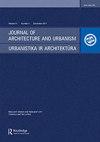伊斯兰文化中的建筑、水和幸福
IF 0.8
0 ARCHITECTURE
引用次数: 0
摘要
本文旨在重新思考水在传统伊斯兰文化和社会中的历史作用、特点、意义和意义。在最终产生伊斯兰文化的地区,长期供水系统的出现导致了复杂的水美学,最常见的是与伊斯兰花园现象联系在一起。这篇文章的作者可以说是一种通才的兴趣,他从思想史的角度审视了伊斯兰园林的这种现象和美学,并试图掌握其普遍特征,这有助于将这种文化现象传播到伊斯兰领域之外,并对中世纪后西欧水文化的发展产生了推动作用。特别是在文艺复兴和巴洛克时期,与一些伊斯兰文化现象的接触变得更加普遍和持久。有人认为,正是伊斯兰教的水文化从现代开始就对西方的想象和文化习俗产生了影响。作者声称,伊斯兰文化在水美学领域的遗产今天可以在各个地区应用和使用,即使水的象征意义在很大程度上已经让位于其他问题,其中包括关于环境的未来。本文章由计算机程序翻译,如有差异,请以英文原文为准。
ARCHITECTURE, WATER AND WELL-BEING IN ISLAMIC CULTURE AND BEYOND
The article aims to reconsider the historical role, peculiarities, significance, and meaning of water in traditional Islamic culture and society. The emergence of long-lasting systems of water supply in the territories that eventually gave rise to Islamic culture resulted in elaborate aesthetics of water most commonly associated with the phenomenon of the Islamic garden. In a piece of what might be described as a generalist’s interest, the author of the article examines this phenomenon and aesthetics of Islamic garden from the point of view of the history of ideas and attempts to grasp its universal features, which contributed to the dissemination of the cultural phenomenon beyond the Islamic realm and hadan impetus on the development of water culture in post-medieval Western Europe, especially during the Renaissance and Baroque eras when encounters with some of the Islamic cultural phenomena became more common and lasting. It is suggested that it was specifically the water culture of Islam that had an impact upon Western imagination and cultural practices from the dawn of the modern era. The author claims that the legacy of Islamic culture in the field of water aesthetics can be applied and used today in various regions even if symbolism of water has largely given ways to other concerns, among them about the future of the environment.
求助全文
通过发布文献求助,成功后即可免费获取论文全文。
去求助
来源期刊

Journal of Architecture and Urbanism
ARCHITECTURE-
CiteScore
1.30
自引率
14.30%
发文量
12
审稿时长
15 weeks
期刊介绍:
The Journal of Architecture and Urbanism publishes original research on all aspects of urban architecture.
 求助内容:
求助内容: 应助结果提醒方式:
应助结果提醒方式:


